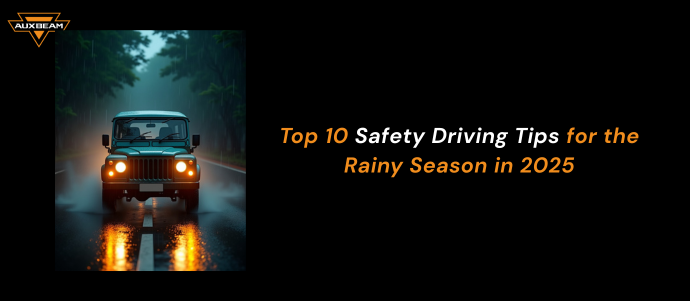Introduction
The monsoon season is one of the most difficult times for drivers because of heavy rains, slippery roads, and low visibility. Following safety driving tips during rainy season can make the difference between a weather-related accident and a safe trip, regardless of whether you're planning a long trip or your daily commute.
Your road safety is our top priority at Auxbeam India. To help you confidently navigate the 2025 monsoon season, we have put together this expert-backed guide. In addition to being general advice, these monsoon driving safety tips are important safety measures meant to keep you, your passengers, and other drivers safe during heavy rain and wet weather conditions.
In this guide, you'll discover:
- ✓ How to prepare your vehicle for the unique challenges of rainy season driving
- ✓ Proper lighting techniques to maximize visibility when roads are wet and foggy
- ✓ Advanced braking and steering methods for maintaining control on slippery surfaces
- ✓ Real-world strategies to avoid hydroplaning and other monsoon driving hazards
Protective driving techniques and years of road safety research provide the foundation for these rainy season safety measures. Using these driving tips for rainy weather will drastically lower your risk of accidents during the worst driving conditions, regardless of your level of experience.
Avoid being caught off guard by the rain. Continue reading to learn how to drive safely in rainy conditions and make every monsoon trip safer in 2025.
1. Before you drive, check your car.
Why it's important Your primary layer of protection against monsoon is a well-maintained car.
Comprehensive checklist:
- Tires: Frequently check the tread depth and pressure. The chance of losing traction is greatly increased by used tires.
- As stopping distances increase in wet conditions, make sure your brakes are active.
- If the wipers leave lines, replace them. Take into account windshield treatments that avoid rain.
- Fluids: Check for leaks and top off washer fluid.
- Lights: Check all of the lights, including the brake, fog, and headlights.
Pro Tip: Stock up on necessary equipment and supplies for an emergency.
2. Reduce Speed and Extend Following Distance
Why it's important Wet roads make it more difficult to stop quickly because they reduce tire traction.
Modifications for safe driving:
- Lower your speed significantly below the posted limit.
- Keep your following distance far longer than normal.
- To avoid slipping, apply the brakes earlier and softer.
Keep in mind that it's better to be late than to run the risk of getting into an accident.
3. Using Headlights and Fog Lights Correctly
In severe rain, visibility is crucial:
- Because high beams can reflect off rain and make it harder to see, use low supports.
- When visibility significantly decreases, turn on fog lights.
- For improved illumination, think about switching to high-performance LED headlights.
Important: Unless required by law, never use hazard lights while operating a motor vehicle.
4. Keep clear of unexpected actions
Accidents are avoided by driving smoothly:
- Apply the brakes gradually and gently.
- With both hands on the wheel, steer smoothly.
- Steer clear of sudden turns that might cause you to lose control.
Driving defensively: Watch out for other drivers who might be having trouble with their conditions.
5. Properly Manage Hydroplaning
What to do in the event that you lose momentum:
- Stay calm and stay away from making sudden movements.
- Reduce the speed gradually.
- Until traction returns, keep the steering wheel straight.
Prevention: Your best defenses are lower speed and proper tire care.
6. Choose the Safest Lane Position
Road awareness is important.
- Drainage is usually better in middle lanes.
- Steer clear of outer lanes where water collects.
- Keep an eye out for oil slicks and hazardous puddles
7. Maintain Clear Visibility
Maintain an unhindered view:
- To avoid fogging, turn on your air conditioner and defroster.
- Treat interior surfaces to prevent fogging.
- Make sure the mirrors are clean and adjusted correctly.
8. Safely Handle Flooded Areas
Precautions for driving in floods:
- If at all possible, avoid driving through standing water.
- If you must, move steadily and slowly.
- Never try to cross swiftly flowing water.
Warning: Even a tiny bit of water can damage an engine or cause loss of control.
9. Using Hazard Lights Properly
When to use them properly:
- Only when halted in a hazardous area.
- Never while operating a motor vehicle (unless authorized by law).
Better substitutes:
- Turn signals should be used earlier than normal.
- To warn oncoming traffic, lightly apply the brakes.
10. Stay Informed About Weather Conditions
Make a safety plan in advance:
- Prior to your trip, check the weather forecast.
- Be aware of other routes in case of flooding.
- Think about delaying travel during strong storms.
In conclusion, 2025 Safe Monsoon Driving
It takes patience, preparation, and the right methods to navigate monsoon conditions safely. You'll be more capable of managing difficult driving conditions during rainy weather if you heed these crucial pointers.
Important driving safety advice for rainy seasons:
- ✔ Always get your car ready before you drive.
- ✔ Modify your speed and following distance.
- ✔ Make sure your lights are turned on correctly for optimal visibility.
- ✔ Be vigilant and aware of potential dangers.
Upgrade to premium LED lighting systems made especially for extreme weather conditions for the best visibility during periods of intense rain.
Use these doable safety tips to drive carefully and prevent accidents during this monsoon season. To keep everyone safe on the roads, share these pointers with your loved ones.













